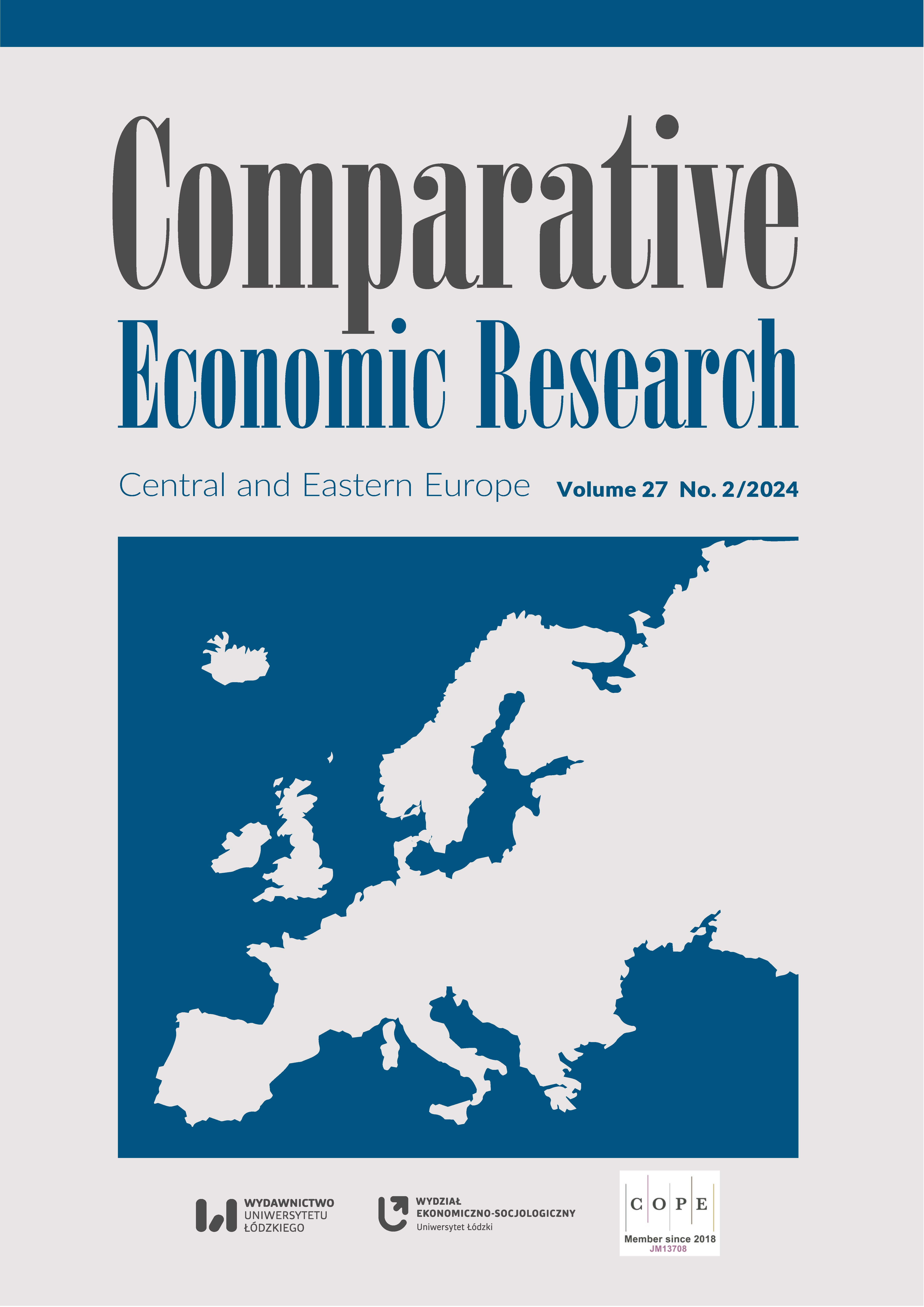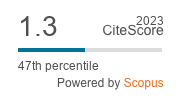Relationships between Inflation and Unemployment in the United States, Japan and Germany during the Economic Crisis Caused by the COVID–19 Pandemic
DOI:
https://doi.org/10.18778/1508-2008.27.11Keywords:
unemployment, inflation, Phillips curve, economic crisis, pandemicAbstract
The aim of the article is to clarify the controversies surrounding the relationship between inflation and unemployment in the three most economically significant countries in the world (apart from China), namely the United States, Japan, and Germany, during the coronavirus pandemic (from January 2020 to February 2022). The pandemic has had various adverse effects worldwide, including a severe economic crisis lasting from the first quarter of 2020 to the end of the first quarter of 2021. The primary causes of this crisis include declines in aggregate supply due to lockdowns in many sectors of the economy, particularly the service sector. A decrease in aggregate supply should cause not only an increase in unemployment but also an increase in inflation. The article, therefore, hypothesises that the relationships between unemployment and inflation in the countries studied during the above period were unidirectional. To verify this hypothesis, two basic research methods were used: analysis of correlation coefficients between the variables mentioned above and the shape of Phillips curves. Ultimately, the hypothesis was rejected because inflation during this period showed a decreasing tendency (mainly due to a significant drop in commodity prices). The article extends research presented in the literature before 2020, offering additional value by examining the period of the pandemic which precipitated an economic crisis. Future analysis should be expanded to include more variables (including the output gap) in line with the New Keynesian Phillips Curve.
Downloads
References
Akerlof, G.A., Dickens, W.T., Perry, G.L. (2000), Near Rational Wage and Price Setting and the Long Run Phillips Curve, “Brooking Papers on Economic Activity”, 1, pp. 1–44, https://doi.org/10.1353/eca.2000.0001
Google Scholar
DOI: https://doi.org/10.1353/eca.2000.0001
Bank of Japan (2020), Minutes of the Monetary Policy Meeting on April 27, 2020, https://www.boj.or.jp/en/mopo/mpmsche_minu/minu_2020/g200427.pdf (accessed: 30.09.2022).
Google Scholar
Bank of Japan (2022), Minutes of the Monetary Policy Meeting on December 16 and 17, 2022, https://www.boj.or.jp/en/mopo/mpmsche_minu/minu_2021/g211217.pdf (accessed: 30.09.2022).
Google Scholar
Baranowski, P. (2011), Efekty oczekiwanego i nieoczekiwanego zacieśnienia polityki pieniężnej w świetle hybrydowego modelu DSGE dla gospodarki Polski, “Ekonomista”, 3, pp. 319–343.
Google Scholar
Belka, M. (1986), Doktryna ekonomiczno społeczna Miltona Friedmana, “Ekonomia XX wieku”, PWN, Warszawa.
Google Scholar
Eller, J.W., Gordon, R.J. (2002), Inflation and Unemployment in the New Economy: Is the Trade off Dead or Alive?, draft of a paper to be presented at Workshop on The Phillips Curve: New Theory and Evidence, Trade Union Institute For Economic Research, Stockholm.
Google Scholar
European Central Bank (2020), Account of the monetary policy meeting of the Governing Council of the European Central Bank held in Frankfurt am Main on Wednesday and Thursday, 29–30 April 2020, https://www.ecb.europa.eu/press/accounts/2020/html/ecb.mg200522~f0355619ae.en.html (accessed: 30.09.2022).
Google Scholar
European Central Bank (2022), Account of the monetary policy meeting of the Governing Council of the European Central Bank held in Frankfurt am Main on Wednesday and Thursday, 15–16 December 2021, https://www.ecb.europa.eu/press/accounts/2022/html/ecb.mg220120~7ed187b5b1.en.html (accessed: 30.09.2022).
Google Scholar
Eurostat (2024a), HICP – monthly data (annual rate of change), https://ec.europa.eu/eurostat/databrowser/view/PRC_HICP_MANR__custom_1829381/default/table?lang=en (accessed: 30.09.2022).
Google Scholar
Eurostat (2024b), HICP – monthly data (annual rate of change), https://ec.europa.eu/eurostat/databrowser/view/prc_hicp_manr/default/table?lang=en (accessed: 30.09.2022).
Google Scholar
Eurostat (2024c), HICP Unemployment by sex and age – monthly data, https://ec.europa.eu/eurostat/databrowser/view/une_rt_m/default/table?lang=en (accessed: 30.09.2022).
Google Scholar
Federal Reserve System (2020), Minutes of the Federal Open Market Committee April 28–29, 2020, https://www.federalreserve.gov/monetarypolicy/files/fomcminutes20200429.pdf (accessed: 30.09.2022).
Google Scholar
Federal Reserve System (2021), Monetary Policy Report – February, 19, 2021, https://www.federalreserve.gov/monetarypolicy/files/20210219_mprfullreport.pdf (accessed: 30.09.2022).
Google Scholar
Federal Reserve System (2022), Monetary Policy Report – June 2022, https://www.federalreserve.gov/monetarypolicy/2022-06-mpr-summary.htm (accessed: 30.09.2022).
Google Scholar
Fisher, I.A. (1926), Statistical Relation between Unemployment and Price Changes, “International Labour Review”, 6, pp. 785–792.
Google Scholar
FRED Economic Data (2021), Consumer Price Index: All Items: Total for Japan, https://fred.stlouisfed.org/series/CPALTT01JPM659N (accessed: 30.09.2022).
Google Scholar
Friedman, M. (1968), The Role of Monetary Policy, “The American Economic Review”, 1, pp. 1–17, https://www.aeaweb.org/aer/top20/58.1.1-17.pdf (accessed: 30.09.2022).
Google Scholar
Friedman, M. (1977), Nobel Lecture: Inflation and Unemployment, “Journal of Political Economy”, 85 (3), pp. 451–472, https://doi.org/10.1086/260579
Google Scholar
DOI: https://doi.org/10.1086/260579
Groshen, E.L., Schweitzer, M.E. (1997), Identifying Inflation’s Grease and Sand Effects in the Labor Market, “NBER Working Paper Series”, 6061, pp. 1–30.
Google Scholar
DOI: https://doi.org/10.26509/frbc-wp-199705
International Monetary Fund (2022), World Economic and Financial Surveys, World Economic Outlook Database, April 2022, https://www.imf.org/en/Publications/WEO/weo-database/2022/April/select-country-group (accessed: 30.09.2022).
Google Scholar
Levy, M.D. (2001), Don’t Mix Monetary and Fiscal: Why Return to an old, Flawed Framework?, “Cato Journal”, 21 (2), pp. 277–283.
Google Scholar
Lucas Jr., R.E. (1973), Some International Evidence on Output Inflation Tradeoffs, “American Economic Review”, June, pp. 326–334, https://www.aeaweb.org/aer/top20/63.3.326-334.pdf (accessed: 30.09.2022).
Google Scholar
Lucas Jr., R.E., Rapping, L.A. (1969), Real Wages, Employment and Inflation, “Journal of Political Economy”, 77 (5), pp. 721–754, https://doi.org/10.1086/259559
Google Scholar
DOI: https://doi.org/10.1086/259559
Mankiw, N.G., Reis, R. (2001), Sticky information versus sticky prices: a proposal to replace the New Keynesian Phillips Curve, “The Quarterly Journal of Economics”, November, pp. 1295–1328, https://doi.org/10.3386/w8290
Google Scholar
DOI: https://doi.org/10.1162/003355302320935034
Nason, J.M., Smith, G.W. (2008), The New Keynesian Phillips Curve: Lessons From Single Equation Econometric Estimation, “Economic Quarterly”, 94, pp. 361–395.
Google Scholar
National Bank of Poland (2021), Minutes of the Monetary Policy Council decision making meeting held on 8 December, https://nbp.pl/wp-content/uploads/2022/10/mi_xii2021en.pdf (accessed: 30.09.2022).
Google Scholar
National Bank of Poland (2022), Minutes of the Monetary Policy Council decision making meeting held on 8 March 2022, https://nbp.pl/wp-content/uploads/2022/10/mi_iii2022en.pdf (accessed: 30.09.2022).
Google Scholar
Niskanen, W.A. (2002), On the Death of the Phillips Curve, “Cato Journal”, 22 (2), pp. 193–198, https://www.cato.org/sites/cato.org/files/serials/files/cato-journal/2002/11/cj22n2-1.pdf (accessed: 30.09.2022).
Google Scholar
Organization for Economic Co operation and Development (2022), Quarterly National Accounts: Quarterly real GDP growth, https://stats.oecd.org/index.aspx?queryid=350 (accessed: 30.09.2022).
Google Scholar
Phelps, E.S. (1967), Phillips Curves, Expectations, of Inflation and Optimal Unemployment Over Time, “Economica”, 34 (135), pp. 254–281, https://doi.org/10.2307/2552025
Google Scholar
DOI: https://doi.org/10.2307/2552025
Phillips, A.W. (1958), The relation Between Unemployment and the Rate of Change of Money Wage Rates in the United Kingdom, 1861–1957, “Economica”, 25 (100), pp. 283–299, https://doi.org/10.2307/2550759
Google Scholar
DOI: https://doi.org/10.1111/j.1468-0335.1958.tb00003.x
Phillips, A.W. (1969), Unemployment and wage rates, [in:] R.J. Ball, P. Doyle (eds.), Inflation: selected readings, Penguin Education, Harmondsworth.
Google Scholar
Roberts, J.M. (1995), New Keynesian and the Phillips Curve, “Journal of Money, Credit, and Banking”, 27 (4, part 1), pp. 975–984, https://doi.org/10.2307/2077783
Google Scholar
DOI: https://doi.org/10.2307/2077783
Samuelson, P.A., Solow, R.M. (1960), Analytical Aspects of Anti Inflation Policy, “The American Economic Review”, 50 (2), pp. 177–194.
Google Scholar
Sargent, T.J., Wallace, N. (1975), “Rational” Expectations, the Optimal Monetary Instrument, and the Optimal Money Supply Rule, “Journal of Political Economy”, 83 (2), pp. 241–254, https://doi.org/10.1086/260321
Google Scholar
DOI: https://doi.org/10.1086/260321
Snowdon, B., Vane, H., Wynarczyk, P. (1998), Współczesne nurty teorii makroekonomii, Wydawnictwo Naukowe PWN, Warszawa.
Google Scholar
Żukowski, R. (1997), Inflacja w procesie transformacji systemowej, [in:] M. Belka, W. Trzeciakowski (eds.), Dynamika transformacji polskiej gospodarki, Instytut Nauk Ekonomicznych PAN, Warszawa, pp. 209–236.
Google Scholar
Downloads
Published
How to Cite
Issue
Section
License

This work is licensed under a Creative Commons Attribution-NonCommercial-NoDerivatives 4.0 International License.











